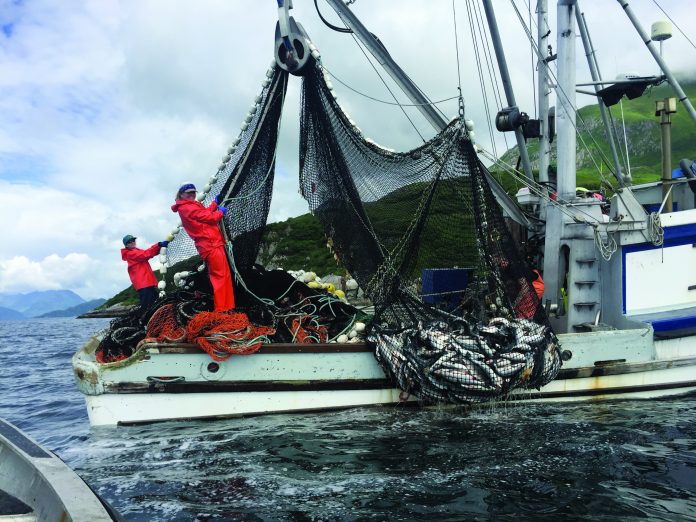
As a California college student back in the 1980s, Theresa Peterson decided to take a chance getting a job at a seafood cannery in Alaska for the summer. She figured that because she hates the cold, she would never go back again.
That first summer she ended up in Homer, where she fell in love with the wilderness beauty of Kachemak Bay. She decided working the slime line in a cold, noisy metal building on the Homer spit was not for her. She got work on a shrimp boast trawling in Kachemak Bay and realized she had found a beautiful wilderness where she could make a living.
“Little did I know I just made a career choice,” Peterson told several dozen young fishermen on Monday, Dec. 6, as she delivered the keynote address at the virtual 2021 Alaska Young Fishermen’s Summit, which offers training and networking opportunities for commercial fishermen early in their careers. The 2021 online event is a temporary solution offered by Alaska Sea Grant to bring young fishermen together safely during the ongoing COVID-19 pandemic, to learn from veteran harvesters like Peterson, industry leaders and fisheries managers.
What began as a summer adventure with hope of finding work ended up becoming Peterson’s life, complete with a fellow harvester named Charlie, now her husband, with whom she shares three children who also fish, and a home in Kodiak.
In 1988, the couple bought a Kodiak seine permit, a 36-foot boat and started seining salmon around Kodiak Island.
“The boat was tiny and reminded me of a floating Tupperware container after working on big steel boats, but it was ours,” she said. “Salmon was our ticket into our own fishing operation and Kodiak was the place to do it with Charlie’s prior experience seining and setnetting around the island since he was 12.”
Over the 33 years since then, Peterson has become not only an accomplished veteran commercial fish harvester, but an advocate for fishermen and an influential participant in the process and politics of this substantial part of Alaska’s economy and lifestyle. Addressing young fisherman, to tell her story and boost them on their way to a successful career in fisheries, was her honor, she told them. And thanks to her multiple experiences over the years, she had plenty of advice to give, from how to buy a fishing boat to navigating federal and state fisheries management entities.
When out to finance a boat, she said, “seek out multiple sources of financing and do your homework. Take some business classes. Talk to others about what they did to finance a fishing operation. Also establish a good credit history and relationships with potential funding organizations.”
In their case, being in their 20s with no credit history, they lucked out because of her husband’s relationship with the owner of a processor, who lent them the money to buy a boat.
That first summer, with her little brother, a cat, a Chesapeake Bay retriever, and a guy from Sweden on board who spoke very little English, proved to be quite an adventure. More experienced fishermen helped them out, “always offering a hand and advice,” she said. “They helped us repair our seine, trouble shoot engine issues and overall kept an eye on us.”
In salmon fishing, and commercial fishing in general, people help each other out all the time, loaning skiffs, nets, parts, all kinds of things to keep each other going; it’s amazing,” she said. “When someone is in trouble, people will stop whatever they are doing to help — that’s just a given.”
Another piece of advice Peterson offered is to always be aware of your surroundings, particularly in inclement weather.
“If I was really uneasy, I would get my survival suit out next to me and stay close to the door out,” she said. “I always kept a flashlight in my bunk so if we lost power, I had light.”
One safety tip: Know where all the safety gear is and have a plan for each situation and take courses from the Alaska Marine Safety Education Association, which are, in her words, “invaluable.”
It’s also important, Peterson said, to keep up on regulatory changes in fisheries and to learn how management systems work on the state and federal level. When the Kodiak area was struggling with poor returns at setnet sites, she got involved with the local fish and game advisory committee, to find common ground amid a lot of internal fighting.
“Little did I know I had just made another major life and career choice that would lead to active engagement in the policy area to support working fishermen,” Peterson said.
In 2004, she took a job with the Alaska Marine Conservation Council working with Kodiak Tanner crab fishermen to identify areas important to Tanner crab. That project led to a local knowledge mapping project and grassroots efforts to support area closures and increased observer coverage in areas identified as important to Tanner crab.
While guiding an idea into becoming a regulation often is a multiyear process, it is critical to stay engaged throughout the process, she said.
“I ended up serving on the Advisory Panel to the council (North Pacific Fishery Management Council) for seven years and the council for three years so I could have a seat at the table advocating on behalf of working fishermen,” Peterson said.
“As one of my fishing buddies says, if you are not at the table, you are on the menu.”
Overall, she advised, “scale your operation to what you are comfortable with, not by what others do.”
Respect the industry, respect each other, respect the marine environment that provides for you and above all be safe and be smart about it all, Peterson said.
“Take advantage of the tremendous number resources out there to support you, and network through your fishing community “and your odds of success will go up.”














